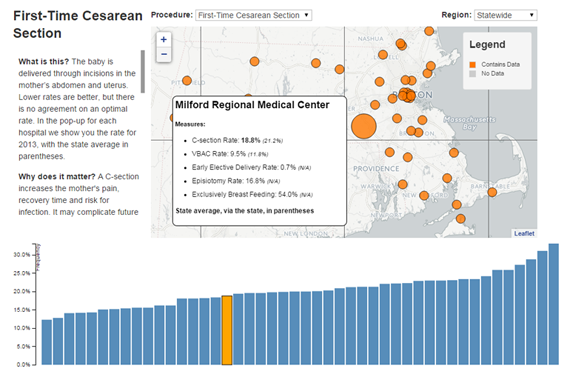When women prepare to give birth, their choice of a hospital is usually dependent on how close it is to their home, where their doctors practice or where their insurance coverage sends them. What they might not realize is that there are often big differences in quality.
In Massachusetts, with a little effort, the 70,000 women who give birth each year can check on those measures that set hospitals apart on a tool developed by Boston public radio station WBUR.
For example:
- — The chance of having a Cesarean section is almost three times higher at some hospitals.
- — Some hospitals bar “early elective” deliveries, where a birth is scheduled before 39 weeks when it’s not medically necessary. Waiting until full-term allows a baby’s brain, lungs and liver to develop.
- — Some hospitals encourage women to try to have a natural delivery after a previous C-section while others will not even offer the option.
“The door you walk in will have a big impact” on what happens during and after childbirth, says Carol Sakala, director of programs at the nonprofit maternity quality group Childbirth Connection.
The hospital where women choose to deliver “absolutely matters,” says Dr. Neel Shah, an assistant professor of obstetrics at Harvard Medical School. Take C-section rates, Shah says. “In many ways, which hospital you go to is a bigger predictor of whether or not you’re going to get a C-section than your own risk or your own preferences.”
For the second year, WBUR compiled the C-section rates and four other childbirth quality measures from state data and hospitals across the state and posted it on the website.
The project follows on a similar effort to collect data on colonoscopies in 2013.
Overall, Sakala says Massachusetts is doing a good job of reducing rates of early elective delivery. But she and other experts see lots of room for improvement on the other four measures.
Shah notes one caveat for the public. He says managing quality is harder for many small hospitals than for larger ones, because small hospitals do not always have the staff to comb through and analyze patient records.“Use the published data as a starting point to ask questions about the nature of care that’s provided at different hospitals and by different providers,” suggests Gene Declercq, a childbirth quality professor at the Boston University School of Public Health, who oversees the website birthbythenumbers.org. “If a hospital is a major outlier, then it is fair to ask them why that’s the case and what that would mean for your care.”
Declercq also urges women to ask how information and instructions are shared between doctors, nurses, midwives and their hospital.
“It is still too easy for women to fall through the cracks in a system where care isn’t coordinated,” Declercq said. He highlights the example of mothers who develop gestational diabetes many of whom do not get “the follow-up care that is essential to prevent problems down the road.”
Women wanting information on what to look for when choosing a hospital could review the list of questions and considerations offered by Bonnie Glass, a nurse who chairs the Massachusetts Perinatal Quality Collaborative.
This story is part of a reporting partnership with NPR, WBUR and Kaiser Health News.








